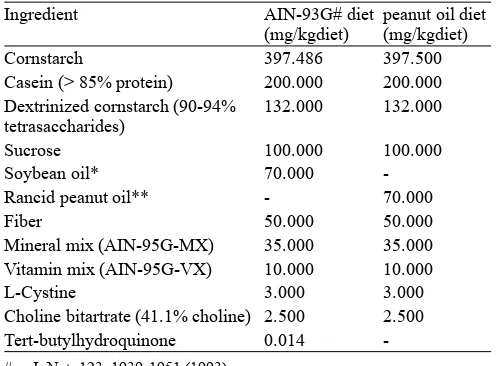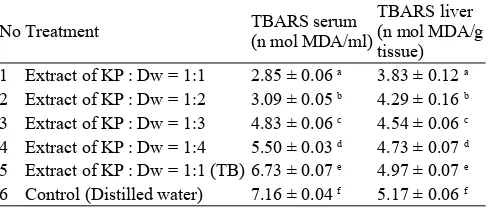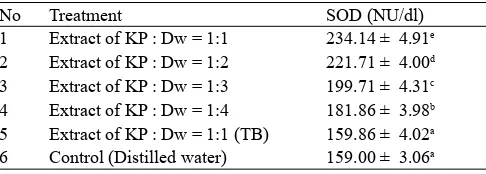ANTIOXIDATIVE PROPERTIES OF WHITE SAFFRON EXTRACT
(
Curcuma mangga
Val.) IN THE
IN VIVO
ASSAY
Dwiyati Pujimulyani
1, Agung Wazyka
1, Sri Anggrahini
2, Umar Santoso
21Faculty of Agroindustry, Mercu Buana University, Jl. Wates Km. 10 Yogyakarta 55753
2Faculty of Agricultural Technology, Gadjah Mada University, Jl. Flora No. 1, Bulaksumur, Yogyakarta 55281
E-mail: [email protected]
ABSTRACT
A study on the antioxidative properties of white saffron extract (in vivo) has been conducted. The purpose of this study was to determine the antioxidative effects of white saffron extract in in vivo assay. Fresh white saffrons were peeled, washed, blanched at 100˚C in 0.5% citric acid solution for 5 minutes and grated. The ratio between grated white saffron and distilled water was 1:1; 1:2; 1:3 and 1:4. Then it was fi ltered in order to obtain white saffron extract. The extract was evaluated in terms of its antioxidant activity by using in vivo. Five-week old male Wistar rats were purchased from Experimental Animal Development Unit, Gadjah Mada University. After one week of adaptation, the rats were divided into six groups, feed and drinking water were provided ad libitum. White saffron extract was orally administrated using a syringe at 09.00 a.m and 14.00 p.m daily, for 14 days. The livers and serum were removed for analysis of thiobarbituric acid reactive subtances (TBARS), α-tocopherols and superoxide dismutase (SOD). The results of this study showed that white saffron extract has an antioxidative activity in the in vivo assay. The higher concentration of white saffron extract, the higher α-tocopherols and superoxide dismutase, but the TBARS value was lower.
Keywords:Curcuma mangga Val., rat, antioxidant activity, in vivo
INTRODUCTION
Antioxidant can be obtained both from natural resources such as curcuminoid from turmeric (Curcuma domestica Val) (Kikuzaki and Nakatani, 1993) and from synthetic materials such as butylated hydroxy anisole (BHA), butylated hydroxy toluene (BHT), tert butyl hydroxy quinone (TBHQ) and propyl gallate (PG) (Sherwin, 1990 in Wanasundara et al., 1994). In general, synthetic antioxidants are very effective, but its safety is still questionable. Therefore its use is tightly regulated in most countries. The current trend of increasing consumer’s awareness and concern about the safety of synthetic additives in food products emphasizes the importance of continuing research in the application of natural antioxidants. Ginger is known for its ability to improve oxidative stability. The study on turmeric oleoresin added to peanut oil at a temperature of 60°C showed its capability to prevent oxidation. Kim et al. (1999) reported that chloroform fraction of Rhus
vernicifl ua extract showed a higher antioxidative activity than
commercial antioxidants, such as BHA and BHT. Therefore, the development of potential natural antioxidant, especially from tubers is needed.
White saffron aroma and taste are similar to ripe mangoes. It is the reason why people name it temu mangga
(Fauziah, 1999). White saffron extracts contains phenolic compounds which is responsible for its antioxidative activity (Pujimulyani et al., 2010). Pujimulyani et al. (2004) reported that white saffron extract exhibited an antioxidant activity in an assay using the emulsion system of β-carotene linoleic acid. In the assay with 2,2-diphenyl-1-picrylhydrazyl (DPPH) method, and ferric-reducing antioxidant power (FRAP), white saffron extract also showed antioxidant activity (Pujimulyani et al., 2010).
Research on white saffron active substance has been done previously. Lestariana et al. (2000) and Atifah (1999) showed that the rhizome juice has cytotoxic activity against B-lymphoblastoid Cell-Lines (B-LCL), but not cytotoxic to B lymphocytes of healthy. White saffron contains ribosome-Inactivating Protein (RIP) that has cytotoxic activity. Juice of the rhizome is able to cut supercoiled DNA into nicked circular and linear, and has N-glycosidase activity that can bypass certain adenine bases in Saccharomyces cereviceae
26s rRNA (Lestariana et al., 2000).
essential oil showed cytotoxic properties against cancer cells Raji greater than HeLa S3 cancer cells. According Karioti et al. (2007), in general diterpenoid is potential immunomodulator. Shiyan (2008) showed that ethanol extract of white saffron can increase the antibody. According to Abas et al. (2004), white saffron extract showed antioxidant activity, that was tested by the FTC method and thiobarbituric acid (TBA).
Some studies showed that blanching increased anti-oxidant activity. Blanching of wheat with pressure at 100ºC after harvesting increased the total phenol of wheat powder (Cheng et al., 2006). Corn blanching with autoclave increased its total phenol (Randhir et al., 2008). The antioxidant activ-ity of beans, corn, and tomato using DPPH method increased after blanching (Kwan et al., 2007). Brussel sprouts (
Bras-sica oleracea L.), after water blanching at 100ºC for 2 and 3
minutes, have higher antioxidant activity compared to fresh brussel sprouts (Viña et al., 2007; Olivera et al., 2008). Bil-berry extract was heated at 100ºC for 10 minutes had higher antioxidant activity compared to fresh extract, because gly-coside was hydrolized into aglycon anthocyanidin and sugar (Yue and Xu, 2008). Zhang et al. (2004) and Sadilova et al. (2006) found that hydrolysis of glycoside anthocyanin into anthocyanidin occurred during heating in acidic condition.
The objective of this study was to examine the antioxi-dative properties of blanched white saffron extract in experi-mental rats (in vivo) and analysis was performed for TBARS, α-tocopherol and superoxidative activity of the livers and in serum.
MATERIALS AND METHODS
The main material in this study was white saffron rhizomes (Curcuma mangga Val.) purchased from local market, butylated hydroxyanisole (BHA), as a reference of antioxidant was purchased from Sigma Chemicals (St. Louis, MO, USA). The equipments used were HPLC, centrifuge, vortex, spectrophotometer (Shimadzu UV-Vis 1601), rotary evaporator (Buchi Rotavapor R-114), microsyringe, and magnetic stirrer.
Preparation of White Saffron Extract
White saffron rhizomes were selected, peeled, washed, blanched in the 0.5% boiling citric acid solution at 100°C for 5 minutes and grated. White saffron extract was prepared by extracting grated rhizomes with a 1:1, 1:2, 1:3 and 1:4 ratio of grated rhizomes to distilled water, and fi nally fi ltered with cheese cloth. White saffron extract was ready to use for in
vivo assays.
The Assay of Antioxidant Activity In Vivo
The antioxidant activity of white saffron extract was
in vivo method. Five-week old Wistar rats were purchased
from UPHP, Gadjah Mada University. Forty two rats were divided into six groups (seven rats/group). The rats were kept individually in cages at a room with temperature of 27+1°C and humidity of 70 + 5%. The feed and drinking water of rats were provided ad libitum. White saffron extract was orally administrated using a syringe at 09.00 a.m and 14.00 p.m daily for 14 days. After one week adaptation with standard diet of AIN-93G, the six groups were fed with rancid peanut oil, with the basic composition followed standard diet of AIN-93G (Table 1.).
Table 1. The composition of the normal diet and rancid peanut oil diet
Casein (> 85% protein) 200.000 200.000
Dextrinized cornstarch (90-94% tetrasaccharides)
132.000 132.000
Sucrose 100.000 100.000
Soybean oil* 70.000
-Rancid peanut oil** - 70.000
Fiber 50.000 50.000
Mineral mix (AIN-95G-MX) 35.000 35.000
Vitamin mix (AIN-95G-VX) 10.000 10.000
L-Cystine 3.000 3.000
Choline bitartrate (41.1% choline) 2.500 2.500
Tert-butylhydroquinone 0.014
-# J. Nutr.123: 1939-1951 (1993) * Wako Pure Chem. Ind. Ltd.
** Lab. of Mercubuana University (stored in the room temperature for 2 years)
The six group in the research: group I was fed with blanched white saffron extract (white saffron:distilled water = 1:1), group II was fed with blanched white saffron extract (white saffron : distilled water = 1:2), group III was fed with blanched white saffron extract (white saffron : distilled water = 1:3), group IV was fed with blanched white saffron extract (white saffron : distilled water = 1:4), group V was fed with non-blanched white saffron extract (white saffron : distilled water = 1:1), group VI was fed with distilled water (without white saffron extract)
was removed for TBARS analysis, α-tocopherols, and SOD (Oyanagui, 1984).
Statistical Analysis
Results from in vivo experiments were analyzed by Duncan’s multiple range test to detect inter group differences where p-values ≤ 0.05 were considered statistically signifi cant.
RESULTS AND DISCUSSION
TBARS Value of Serum and liver
The value of TBARS serum and livers, which were added with oxidized peanut oil diet and white saffron extract are shown in Table 2.
Table 2. TBARS Value of serum and liver
No Treatment TBARS serum Dw : Distilled water
Means with the same superscript in the same columns are not signifi cantly different
Table 2 shows that the diet of oxidized peanut oil causes the value of serum lipid peroxides to be higher than the rats which were given white saffron extract orally with 1 ml/rat twice a day for 14 days. It shows that oxidized peanut oil containing unsaturated fatty acid causes cellular membranes to have lipid oxidation (Saito and Nakatsugawa, 1994; Simopoukus, 1991; Hue et al, 1989). Giving white saffron extract at all variation shows that TBARS value is signifi cantly lower compared to the given with of distilled water. Giving blanched white saffron extract at all variation shows that TBARS value is signifi cantly lower compared to that of given with non-blanched white saffron. This might be due to the hydrolysis of quercetin-3-rutinoside of white saffron during blanching into aglicone quercetin. It was found that quercetin showed higher antioxidant activity than quersetin-3-rutinoside as measured by FRAP method (Pujimulyani, 2010). Li et al. (2009) reported that aglicone had higher antioxidant activity than glycoside. Other study also reported that anthocyanin of bilberry extract was hydrolyzed during heating (Yue and Xu, 2008). The higher concentration of white saffron extract,
the lower TBARS serum value. It shows that white saffron extract can inhibit the oxidation of lipid rat livers that were given with diet of oxidized peanut oil, this white saffron extract shows an evident of containing the antioxidant.
TBARS value of rat liver given with oxidized peanut oil diet have the same trend with that of serum, whereas, the higher concentration of white saffron extract given, the lower the liver TBARS. This suggests that white saffron extract is able to inhibit the lipid oxidation in rat livers given with oxidized peanut oil diet. Therefore, this proves that white saffron extract contains the antioxidant substance.
α-Tocopherol Serum Content and Livers of Rats
Alpha-tocopherol in the serum and rat livers with the diet of oxidized peanut oil and were given white saffron extract are shown in Table 3.
Table 3. α- tocopherol in serum and liver of rats
Kel Treatment α-tocopherol
serum (μg/dl) Dw : Distilled water TB : Non blanching
Means with the same superscript in the same columns are not signifi canlly different.
Rat serum which was added oxidized peanut oil diet without white saffron extract (control) shows the lowest α-tocopherol content, while rats which were given the higher white saffron obviously showed higher α- tocopherol content. It shows that white saffron extract is able to inhibit the lack of antioxidants such as α- tocopherol in the treatment rat. White saffron extract with blanching treatment signifi cantly shows the higher antioxidant activity compared to the one without blanching. It is possible for white saffron without blanching process that existing pigment to function as sensitizer in the fotooxidation with the light existed (Raharjo, 2004). Pujimulyani et al. (2010) showed that total phenol and total
fl avonoid in blanched white saffron are higher than non-blanched ones.
α-tocopherol livers of rat control were the lowest. It proves that white saffron extract can inhibit the lack of antioxidants such as α-tocopherol in the rat treatment livers.
Serum Superoxide Dismutase (SOD) of Rats
SOD content in the serum of rat treatment is shown in Table 4. The table shows that there is a signifi cant increase of SOD content of rat serums which were given white saffron extract in the various solvents used. This is related to the factors that cause the TBARS value of rats given with dietary feed to be lower. White saffron extract contains curcuminoid (Pujimulyani and Sutardi, 2003), but the existence of antioxidant activity is not only caused by the curcumnoid, but also by the fact that there are catechin (C), epicatechin (EC), epigallocatechin (EGC), epigallocatechingallat (EGCG) and gallocatechingallat (GCG) and quercetin (Pujimulyani, 2010).
Table 4. Superoxide dismutase (SOD) value of rats serum
No Treatment SOD (NU/dl)
1 Extract of KP : Dw = 1:1 234.14 ± 4.91e
2 Extract of KP : Dw = 1:2 221.71 ± 4.00d
3 Extract of KP : Dw = 1:3 199.71 ± 4.31c
4 Extract of KP : Dw = 1:4 181.86 ± 3.98b
5 Extract of KP : Dw = 1:1 (TB) 159.86 ± 4.02a
6 Control (Distilled water) 159.00 ± 3.06a
KP : white saffron Dw : Distilled water TB : Non blanching NU : Nitrit unit
Means with the same superscript in the same columns are not signifi canlly different.
CONCLUSIONS
The white saffron extract exhibits an antioxidant activity in the in vivo assay. The higher concentration of white saffron extract results in a higher antioxidant activity, α-tocopherol, and SOD, but the TBARS decreases.
ACKNOWLEDGEMENTS
Authors wish to thank the Directorate General of Higher Education (DGHE) Ministry of National Education of Republic of Indonesia for providing fund for this study. Authors also wish to thank Pipiet Ariwibowo, S.TP, Dhani Rahmanu, S.TP, and Elies Hastarisa S.TP for their technical assistance in the Laboratory.
REFERENCES
Abas, F., Nordin H.L., Shaari, K., Israf, D.A., Stanslasnan, J. and Yusuf, U.K. (2004). Antioxidant and nitric oxide inhibition activities of selected malay traditional vegetables.Journal of Natural Product65: 831-835.
Atifah N. (1999). Uji Aktivitas Sitotoksik Kunir Putih
(Cur-cuma mangga Val.) terhadap β-Lymphobla Stoid Cell
Lines, Fakultas Farmasi, Universitas Gadjah Mada,
Yogyakarta.
Budiman, H. (2001). Uji Sitotoksisitas Kandungan Metabolit Sekunder Rimpang Curcuma mangga Val. pada Sel
Hela-S3 dan Raji serta Identifi kasi Struktur Kimianya.
Universitas Gadjah Mada, Yogyakarta.
Cheng, Z., Su, L., Moore, J., Zhou, K., Luther, M., Yin. J. and Yu. L. (2006). Effects of post harvest treatment and heatstress on availability of wheat antioxidants. Journal
of Agriculture and Food Chemistry54: 5623-5629.
Fauziah, M. (1999). Temu-temuan dan Empon-empon,
Budi-daya dan Manfaatnya, Kanisius. Yogyakarta
Hue, M-L., Frankel, E.N., Leibovits, B.E. and Tappel, A.L. (1989). Effect of dietary lipids and vitamin E on in vitro lipid peroxidation in rat liver and kidney homogenates.
Journal of Nutrition 19: 1574-1582.
Karioti, A., Akopeliti, M., Tsitsilonis, O., Heilmann J. and Skaltsa H. (2007). Cytotoxicity and immunomodulating characteristics of labdane diterpenes from marrubium cylleneum and marrubium velutinum. Phytochemistry
174-175.
Kikuzaki, H. and Nakatami, N. (1993). Antioxidant effect of some ginger constituents. Journal of Food Science 58: 1407-1410.
Kwan, Y.I., Apostolidis, E. and Shetty, K. (2007). Traditional diet of americans for management of diabetes and hypertension. Journal of Medicinal Food10: 266-275.
Lestariana, W., Triandiasih, H., Sismindari and Mubarika, S. (2000). Identifi kasi Protein Aktif dalam Curcuma
mangga Val. dan Uji Aktivitasnya pada DNA Superkoil.
Buletin ISFI3: 25-30.
Li., C., Du, H., Wang, L., Shu, Q., Zheng, Y., Xu, Y., Zhang, J., Yang, R., and Ge, Y. (2009). Flavonoid composition and antioxidant activity of tree peony (Paeonia section moutan) yellow fl owers. Journal of Agriculture and
Food Chemistry57: 8496-8503.
Raji dan Hela-S3, Fakultas Farmasi, Universitas Gadjah Mada, Yogyakarta.
Ohkawa, H., Ohishi, N. and Yagi, K. (1979). Assay for lipid peroxides in animal tissues by thiobarbituric acid reaction. Analitycal Biochemitical 95: 351-358.
Olivera, D.F., Vina, S.Z., Marani, C.M., Ferreyra, R.M., Mugride, A., Chaves, A.R., and Mascheroni, R.H. (2008). Effect of blanching on the quality of brussels sprouts (Brassica olereceae L. gemmifera DC) after frozen stroge. Journal of Food Engineering 84 :148-155.
Oyanagui, Y. (1984). Reevaluation of assay methods and establisment of kit for superoxide dismutase activity.
Analitical Biochemistry 142:290-296.
Pujimulyani, D. and Sutardi (2003). Curcuminoid content and antioxidative properties on white saffron extract
(Curcuma mangga Val). Proceeding International
Con-ference Redesigning Sustainable Development on Food and Agricultural System for Developing Countries,
517-529.
Pujimulyani, D., Wazyka, A., S. Anggrahini, S. and Santoso, U. (2004). Antioksidative propertis of white saffron extract (Curcuma mangga Val.) in the β-carotene blanching and DPPH- radical scavenging methods.
Journal Indonesian Food and Nutrition Progress2:
35-40.
Pujimulyani, D., Raharjo, S., Marsono, Y., and Santoso, U. (2010). The effects of blanching treatment on the radical scavenging activity of white saffron (Curcuma
mangga Val.). International Food Research Journal17:
615-621.
Pujimulyani, D. (2010). Peningkatan Aktivitas Antioksidan Pada Kunir Putih Putih (Curcuma mangga Val.) Akibat
Blanching, Disertasi S3, Universitas Gadjah Mada,
Yogyakarta.
Raharjo, S. (2004). Kerusakan Oksidatif pada Makanan, PSPG, Universitas Gadjah Mada, Yogyakarta.
Randhir, R., Kwan, Y. I. dan Shetty, K. (2008). Effect of thermal processing on phenolics, antioxidant activity and health-relevant functionality of select grain sprouts and seedlings. Innovative Food Science and Emerging
Technology9: 355-364.
Sadilova, E., Stintzing E.C. and Carle, R. (2006). Thermal degradation of acylated and nonacylated anthocyanins.
Journal of Food Science71: C504-512.
Saito, M. and Nakatsugawa, K. (1994). Increased susceptibility of liver to lipid peroxidation afteri of a high fi sh oil diet.
International Journal of Vitamin Nutrition Research 64:
144-151.
Shiyan, S. (2008). Efek Ekstrak Etanolik Curcuma mangga Val. terhadap Peningkatan Titer Antibodi pada Serum
dan Kuning Telur Itik Terinduksi Vasin H SNI, Fakultas
Farmasi, Universitas Gadjah Mada,Yogyakarta.
Simopoukus, A.P. (1991). Omega-3 fatty acids in health and disease and in growth and development. America
Journal of Clinical Nutrition 54: 438-463.
Viña, S.Z., Daniela, F.O., Claudia, M.M., Ricardo, M.F., Alicia, M., Chaves, A.R. and Rodolfo H.M. (2007). Quality of brussels sprouts (Brassica oleracea L. gemmifera DC) as affected by blanching method.
Journal of Food Engineering 80: 218-225.
Wanasundara, U., Amarowicz, R. and Shahidi, F. (1994). Isolation and identifi cation of an antioxidative compo-nent in canola meal. Journal of Agriculture and Food
Chemistry 42: 1285-1290.
Yue X. and Xu, Z. (2008). Changes of anthocyanins, anthocyanidins, antioxidant activity in bilberry extract during dry heating. Journal of Food Science73: 692-696.
Zhang, Z., Kou X., Fugal K., and Mclaughlin, J. (2004). Comparison of HPLC methods for determination of anthocyanins and anthocyanidins in bilberry extracts.


